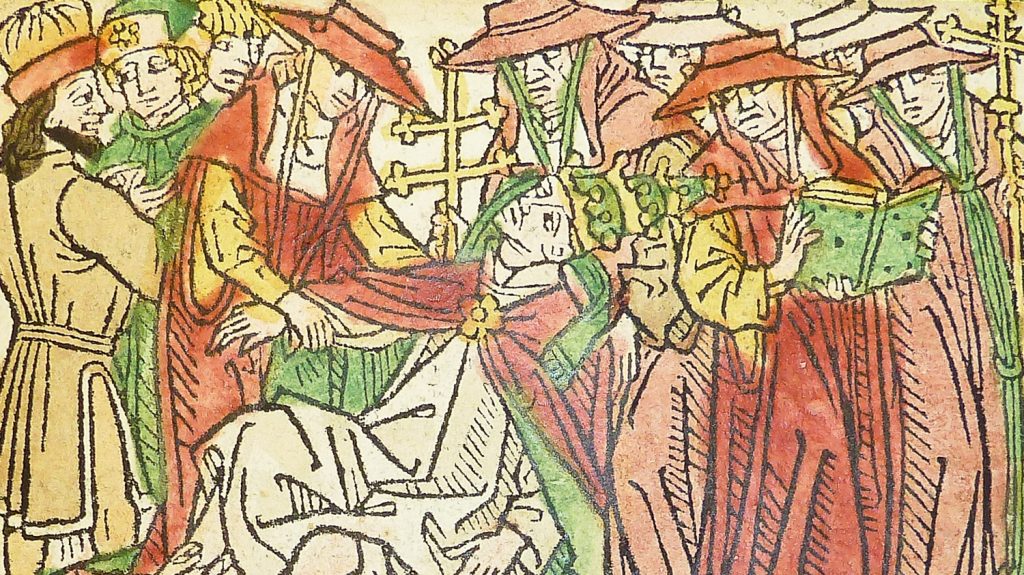The fictional Pope Joan began her ascent to the Chair of St Peter today in the year 855, when Pope Leo IV died. According to the legends, which were widely believed even after they were debunked in the 16th century, Joan disguised herself as a man, and no one noticed as she rose through the ranks of clergy. Her gender was only discovered when, in an epic case of bad timing, she gave birth during a papal procession (above). A postscript to the legends says that subsequent Popes had to submit to a physical examination by a cardinal, through a hole in a chair, to make sure he had the equipment to be a Pope. If the result was positive, the cardinal would announce: Duos habet et bene pendentes (‘He has two, and they dangle nicely’), which is probably the best bit of liturgy ever.
‘A certain woman, learned and well versed in the notary’s art, assuming male clothing and pretending to be a man, came to Rome. Through her diligence as well as her learning in letters, she was appointed as a curial secretary. Afterwards, under the Devil’s direction, she was made a cardinal and finally pope. Having become pregnant she gave birth while mounting a horse.’ Stephen of Bourbon, De Diversis Materiis Praedicabilibus, 13th century
Isaac Watts, the pioneering hymn writer, was born today in 1764. He wrote some enduringly great hymns, such as ‘O God our help in ages past’, and ‘When I survey the wondrous cross’. Among his lesser hits is ‘Blest is the man whose bowels move’, a hymn the Victorians realised might trigger congregational sniggering. They therefore edited the line to ‘Blest is the man whose breast can move’, which brilliantly removed any possible double entendre.
Two months after becoming Pope, Paul IV issued one of the most infamous papal bulls in Church history, today in 1555. The bull, Cum nimis absurdum (‘Since it is absurd’), complained that it was absurd that Christians allowed Jews to live freely in society, and decreed a host of restrictions on their way of life. The Jews of Rome were forced to live in a ghetto, a walled section of the city with just three gates which were locked at night. Men had to wear a pointed yellow hat, and women a yellow scarf, in a premonition of the infamous yellow identity badges imposed on Jewish people by the Nazis in the 20th century. The Jews lived in the Roman ghetto for over 300 years, until it was abolished in 1870.
Martin Luther, 21 years old, interrupted his university education to join the Augustinian monastery in Erfurt on this day in 1505, fulfilling a vow he made to St Anne when he was terrified in a thunderstorm. Luther wore the habit of a monk for 19 years, and threw himself into the monastic life so completely that he later boasted:
‘I was a good monk, and I kept the rule of my order so strictly that I may say that if ever a monk got to heaven by his monkery it was I. All my brothers in the monastery who knew me will bear me out. If I had kept on any longer, I should have killed myself with vigils, prayers, reading, and other work.’ Martin Luther
It is the feast of a 5th century saint who later enjoyed huge popularity in medieval times. Alexis, the son of a wealthy Roman family, left it all to embrace poverty and homelessness in Syria. According to legend, he eventually returned home and lived incognito as a lowly servant in his old family home, sleeping under the stairs.
Image: Provenance Online Project
